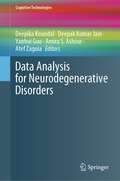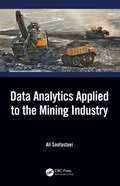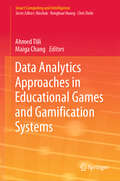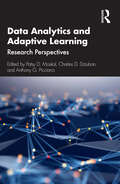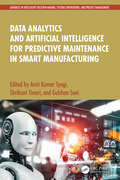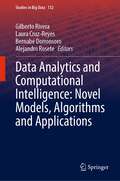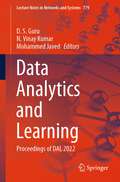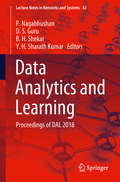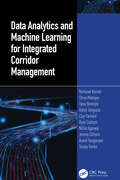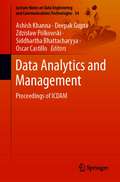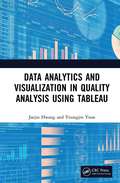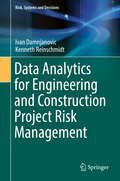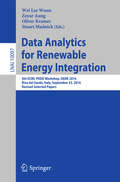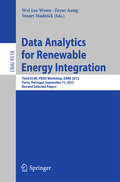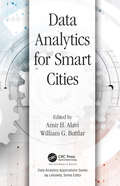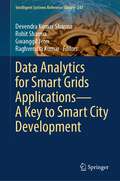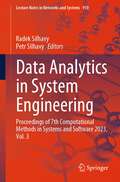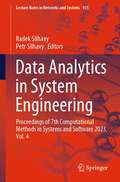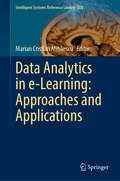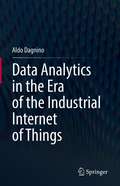- Table View
- List View
Data Analysis for Neurodegenerative Disorders (Cognitive Technologies)
by Amira S. Ashour Yanhui Guo Deepika Koundal Deepak Kumar Jain Atef ZaguiaThis book explores the challenges involved in handling medical big data in the diagnosis of neurological disorders. It discusses how to optimally reduce the number of neuropsychological tests during the classification of these disorders by using feature selection methods based on the diagnostic information of enrolled subjects. The book includes key definitions/models and covers their applications in different types of signal/image processing for neurological disorder data. An extensive discussion on the possibility of enhancing the abilities of AI systems using the different data analysis is included. The book recollects several applicable basic preliminaries of the different AI networks and models, while also highlighting basic processes in image processing for various neurological disorders. It also reports on several applications to image processing and explores numerous topics concerning the role of big data analysis in addressing signal and image processing in various real-world scenarios involving neurological disorders.This cutting-edge book highlights the analysis of medical data, together with novel procedures and challenges for handling neurological signals and images. It will help engineers, researchers and software developers to understand the concepts and different models of AI and data analysis. To help readers gain a comprehensive grasp of the subject, it focuses on three key features:● Presents outstanding concepts and models for using AI in clinical applications involving neurological disorders, with clear descriptions of image representation, feature extraction and selection.● Highlights a range of techniques for evaluating the performance of proposed CAD systems for the diagnosis of neurological disorders.● Examines various signal and image processing methods for efficient decision support systems. Soft computing, machine learning and optimization algorithms are also included to improve the CAD systems used.
Data Analytics Applied to the Mining Industry
by Ali SoofastaeiData Analytics Applied to the Mining Industry describes the key challenges facing the mining sector as it transforms into a digital industry able to fully exploit process automation, remote operation centers, autonomous equipment and the opportunities offered by the industrial internet of things. It provides guidelines on how data needs to be collected, stored and managed to enable the different advanced data analytics methods to be applied effectively in practice, through use of case studies, and worked examples. Aimed at graduate students, researchers, and professionals in the industry of mining engineering, this book: Explains how to implement advanced data analytics through case studies and examples in mining engineering Provides approaches and methods to improve data-driven decision making Explains a concise overview of the state of the art for Mining Executives and Managers Highlights and describes critical opportunity areas for mining optimization Brings experience and learning in digital transformation from adjacent sectors
Data Analytics Approaches in Educational Games and Gamification Systems (Smart Computing and Intelligence)
by Maiga Chang Ahmed TliliGame-based learning environments and learning analytics are attracting increasing attention from researchers and educators, since they both can enhance learning outcomes. This book focuses on the application of data analytics approaches and research on human behaviour analysis in game-based learning environments, namely educational games and gamification systems, to provide smart learning. Specifically, it discusses the purposes, advantages and limitations of applying such approaches in these environments. Additionally, the various smart game-based learning environments presented help readers integrate learning analytics in their educational games and gamification systems to, for instance, assess and model students (e.g. their computational thinking) or enhance the learning process for better outcomes. Moreover, the book presents general guidelines on various aspects, such as collecting data for analysis, game-based learning environment design, system architecture and applied algorithms, which facilitate incorporating learning analytics into educational games and gamification systems.After a general introduction to help readers become familiar with the subject area, the individual chapters each discuss a different aim of applying data analytics approaches in educational games and gamification systems. Lastly, the conclusion provides a summary and presents general guidelines and frameworks to consider when designing smart game-based learning environments with learning analytics.
Data Analytics and Adaptive Learning: Research Perspectives
by Patsy D. Moskal, Charles D. Dziuban, and Anthony G. PiccianoData Analytics and Adaptive Learning offers new insights into the use of emerging data analysis and adaptive techniques in multiple learning settings. In recent years, both analytics and adaptive learning have helped educators become more responsive to learners in virtual, blended, and personalized environments. This set of rich, illuminating, international studies spans quantitative, qualitative, and mixed-methods research in higher education, K–12, and adult/continuing education contexts. By exploring the issues of definition and pedagogical practice that permeate teaching and learning and concluding with recommendations for the future research and practice necessary to support educators at all levels, this book will prepare researchers, developers, and graduate students of instructional technology to produce evidence for the benefits and challenges of data-driven learning.
Data Analytics and Artificial Intelligence for Predictive Maintenance in Smart Manufacturing (Advances in Intelligent Decision-Making, Systems Engineering, and Project Management)
by Amit Kumar Tyagi Shrikant Tiwari Gulshan SoniToday, in this smart era, data analytics and artificial intelligence (AI) play an important role in predictive maintenance (PdM) within the manufacturing industry. This innovative approach aims to optimize maintenance strategies by predicting when equipment or machinery is likely to fail so that maintenance can be performed just in time to prevent costly breakdowns. This book contains up-to-date information on predictive maintenance and the latest advancements, trends, and tools required to reduce costs and save time for manufacturers and industries.Data Analytics and Artificial Intelligence for Predictive Maintenance in Smart Manufacturing provides an extensive and in-depth exploration of the intersection of data analytics, artificial intelligence, and predictive maintenance in the manufacturing industry and covers fundamental concepts, advanced techniques, case studies, and practical applications. Using a multidisciplinary approach, this book recognizes that predictive maintenance in manufacturing requires collaboration among engineers, data scientists, and business professionals and includes case studies from various manufacturing sectors showcasing successful applications of predictive maintenance. The real-world examples explain the useful benefits and ROI achieved by organizations. The emphasis is on scalability, making it suitable for both small and large manufacturing operations, and readers will learn how to adapt predictive maintenance strategies to different scales and industries. This book presents resources and references to keep readers updated on the latest advancements, tools, and trends, ensuring continuous learning.Serving as a reference guide, this book focuses on the latest advancements, trends, and tools relevant to predictive maintenance and can also serve as an educational resource for students studying manufacturing, data science, or related fields.
Data Analytics and Computational Intelligence: Novel Models, Algorithms and Applications (Studies in Big Data #132)
by Bernabé Dorronsoro Alejandro Rosete Gilberto Rivera Laura Cruz-ReyesIn the age of transformative artificial intelligence (AI), which has the potential to revolutionize our lives, this book provides a comprehensive exploration of successful research and applications in AI and data analytics. Covering innovative approaches, advanced algorithms, and data analysis methodologies, this book addresses complex problems across topics such as machine learning, pattern recognition, data mining, optimization, and predictive modeling. With clear explanations, practical examples, and cutting-edge research, this book seeks to expand the understanding of a wide readership, including students, researchers, practitioners, and technology enthusiasts eager to explore these exciting fields. Featuring real-world applications in education, health care, climate modeling, cybersecurity, smart transportation, conversational systems, and material analysis, among others, this book highlights how these technologies can drive innovation and generate competitive advantages.
Data Analytics and Learning: Proceedings of DAL 2022 (Lecture Notes in Networks and Systems #779)
by D. S. Guru N. Vinay Kumar Mohammed JavedThis book presents new theories and working models in the areas of data analytics and learning. The papers included in this volume were presented at the second International Conference on Data Analytics and Learning (DAL 2022), which was organized by the Department of Computer Science & Engineering, Alva’s Institute of Engineering & Technology, Moodbidri, Mangalore, Karnataka, India in association with the Department of Studies in Computer Science, University of Mysore, Mysuru, Karnataka, India. The areas covered include pattern recognition, image processing, deep learning, computer vision, data analytics, machine learning, artificial intelligence, and intelligent systems.
Data Analytics and Learning: Proceedings of Dal 2018 (Lecture Notes in Networks and Systems #43)
by D. S. Guru P. Nagabhushan B. H. Shekar Y. H. Sharath KumarThis paper describes a method to localize and recognize seven-segment displays on digital energy meters. Color edge detection is first performed on a camera-captured image of the device which is then followed by a run-length technique to detect horizontal and vertical lines. The region of interest circumscribing the LCD panel is determined based on the attributes of intersecting horizontal and vertical lines. The extracted display region is preprocessed using the morphological black-hat operation to enhance the text strokes. Adaptive thresholding is then performed and the digits are segmented based on stroke features. Finally, the segmented digits are recognized using a support vector machine classifier trained on a set of syntactic rules defined for the seven-segment font. The proposed method can handle images exhibiting uneven illumination, the presence of shadows, poor contrast, and blur, and yields a recognition accuracy of 97% on a dataset of 175 images of digital energy meters captured using a mobile camera.
Data Analytics and Machine Learning for Integrated Corridor Management
by Sanjay Ranka Anand Rangarajan Tania Banerjee Yashawi Karnati Dhruv Mahajan Rahul Sengupta Packard Clay Ryan Casburn Nithin Agarwal Jeremy DilmoreIn an era defined by rapid urbanization and ever-increasing mobility demands, effective transportation management is paramount. This book takes readers on a journey through the intricate web of contemporary transportation systems, offering unparalleled insights into the strategies, technologies, and methodologies shaping the movement of people and goods in urban landscapes.From the fundamental principles of traffic signal dynamics to the cutting-edge applications of machine learning, each chapter of this comprehensive guide unveils essential aspects of modern transportation management systems. Chapter by chapter, readers are immersed in the complexities of traffic signal coordination, corridor management, data-driven decision-making, and the integration of advanced technologies. Closing with chapters on modeling measures of effectiveness and computational signal timing optimization, the guide equips readers with the knowledge and tools needed to navigate the complexities of modern transportation management systems.With insights into traffic data visualization and operational performance measures, this book empowers traffic engineers and administrators to design 21st-century signal policies that optimize mobility, enhance safety, and shape the future of urban transportation.
Data Analytics and Management: Proceedings of ICDAM (Lecture Notes on Data Engineering and Communications Technologies #54)
by Oscar Castillo Siddhartha Bhattacharyya Deepak Gupta Ashish Khanna Zdzisław PólkowskiThis book includes original unpublished contributions presented at the International Conference on Data Analytics and Management (ICDAM 2020), held at Jan Wyzykowski University, Poland, during June 2020. The book covers the topics in data analytics, data management, big data, computational intelligence, and communication networks. The book presents innovative work by leading academics, researchers, and experts from industry which is useful for young researchers and students.
Data Analytics and Visualization in Quality Analysis using Tableau
by Jaejin Hwang Youngjin YoonData Analytics and Visualization in Quality Analysis using Tableau goes beyond the existing quality statistical analysis. It helps quality practitioners perform effective quality control and analysis using Tableau, a user-friendly data analytics and visualization software. It begins with a basic introduction to quality analysis with Tableau including differentiating factors from other platforms. It is followed by a description of features and functions of quality analysis tools followed by step-by-step instructions on how to use Tableau. Further, quality analysis through Tableau based on open source data is explained based on five case studies. Lastly, it systematically describes the implementation of quality analysis through Tableau in an actual workplace via a dashboard example. Features: Describes a step-by-step method of Tableau to effectively apply data visualization techniques in quality analysis Focuses on a visualization approach for practical quality analysis Provides comprehensive coverage of quality analysis topics using state-of-the-art concepts and applications Illustrates pragmatic implementation methodology and instructions applicable to real-world and business cases Include examples of ready-to-use templates of customizable Tableau dashboards This book is aimed at professionals, graduate students and senior undergraduate students in industrial systems and quality engineering, process engineering, systems engineering, quality control, quality assurance and quality analysis.
Data Analytics for Cultural Heritage: Current Trends and Concepts
by Abdelaziz Bouras Abdul Hamid Sadka Abdelhak Belhi Abdulaziz Khalid Al-AliThis book considers the challenges related to the effective implementation of artificial intelligence (AI) and machine learning (ML) technologies to the cultural heritage digitization process. Particular focus is placed on improvements to the data acquisition stage, as well as the data enrichment and curation stages, using advanced artificial intelligence techniques and tools. An emphasis is placed on recent applications related to deep learning for visual recognition, generative models, natural language processing, and super resolution. The book is a valuable reference for researchers working in the multidisciplinary field of cultural heritage and AI, as well as professional experts in the art and culture domains, such as museums, libraries, and historic sites and buildings. Reports on techniques and methods that leverage AI and machine learning and their impact on the digitization of cultural heritage; Addresses challenges of improving data acquisition, enrichment and management processes;Highlights contributions from international researchers from diverse fields and subject areas.
Data Analytics for Drilling Engineering: Theory, Algorithms, Experiments, Software (Information Fusion and Data Science)
by Qilong XueThis book presents the signal processing and data mining challenges encountered in drilling engineering, and describes the methods used to overcome them. In drilling engineering, many signal processing technologies are required to solve practical problems, such as downhole information transmission, spatial attitude of drillstring, drillstring dynamics, seismic activity while drilling, among others. This title attempts to bridge the gap between the signal processing and data mining and oil and gas drilling engineering communities. There is an urgent need to summarize signal processing and data mining issues in drilling engineering so that practitioners in these fields can understand each other in order to enhance oil and gas drilling functions. In summary, this book shows the importance of signal processing and data mining to researchers and professional drilling engineers and open up a new area of application for signal processing and data mining scientists.
Data Analytics for Engineering and Construction Project Risk Management (Risk, Systems and Decisions)
by Ivan Damnjanovic Kenneth ReinschmidtThis book provides a step-by-step guidance on how to implement analytical methods in project risk management. The text focuses on engineering design and construction projects and as such is suitable for graduate students in engineering, construction, or project management, as well as practitioners aiming to develop, improve, and/or simplify corporate project management processes.The book places emphasis on building data-driven models for additive-incremental risks, where data can be collected on project sites, assembled from queries of corporate databases, and/or generated using procedures for eliciting experts’ judgments. While the presented models are mathematically inspired, they are nothing beyond what an engineering graduate is expected to know: some algebra, a little calculus, a little statistics, and, especially, undergraduate-level understanding of the probability theory.The book is organized in three parts and fourteen chapters. In Part I the authors provide the general introduction to risk and uncertainty analysis applied to engineering construction projects. The basic formulations and the methods for risk assessment used during project planning phase are discussed in Part II, while in Part III the authors present the methods for monitoring and (re)assessment of risks during project execution.
Data Analytics for Internet of Things Infrastructure (Internet of Things)
by Rohit Sharma Yan Zhang Gwanggil JeonThis book provides techniques for the deployment of semantic technologies in data analysis along with the latest applications across the field such as Internet of Things (IoT). The authors focus on the use of the IoT and big data in business intelligence, data management, Hadoop, machine learning, cloud, smart cities, etc. They discuss how the generation of big data by IoT has ruptured the existing data processing capacity of IoT and recommends the adoption of data analytics to strengthen solutions. The book addresses the challenges in designing the web based IoT system, provides a comparative analysis of different advanced approaches in industries, and contains an analysis of databases to provide expert systems. The book aims to bring together leading academic scientists, researchers, and research scholars to exchange and share their experiences and research results on all aspects of IoT and big data analytics.
Data Analytics for Renewable Energy Integration: 4th ECML PKDD Workshop, DARE 2016, Riva del Garda, Italy, September 23, 2016, Revised Selected Papers (Lecture Notes in Computer Science #10097)
by Oliver Kramer Wei Lee Woon Zeyar Aung Stuart MadnickThis book constitutes revised selected papers from the second ECML PKDD Workshop on Data Analytics for Renewable Energy Integration, DARE 2014, held in Nancy, France, in September 2014. The 11 papers presented in this volume were carefully reviewed and selected for inclusion in this book.
Data Analytics for Renewable Energy Integration: 5th ECML PKDD Workshop, DARE 2017, Skopje, Macedonia, September 22, 2017, Revised Selected Papers (Lecture Notes in Computer Science #10691)
by Wei Lee Woon, Zeyar Aung, Oliver Kramer and Stuart MadnickThis book constitutes revised selected papers from the 5th ECML PKDD Workshop on Data Analytics for Renewable Energy Integration, DARE 2017, held in Skopje, Macedonia, in September 2017. The 11 papers presented in this volume were carefully reviewed and selected for inclusion in this book and handle topics such as time series forecasting, the detection of faults, cyber security, smart grid and smart cities, technology integration, demand response and many others.
Data Analytics for Renewable Energy Integration: Third ECML PKDD Workshop, DARE 2015, Porto, Portugal, September 11, 2015. Revised Selected Papers (Lecture Notes in Computer Science #9518)
by Wei Lee Woon Zeyar Aung Stuart MadnickThis book constitutes revised selected papers from the second ECML PKDD Workshop on Data Analytics for Renewable Energy Integration, DARE 2014, held in Nancy, France, in September 2014. The 11 papers presented in this volume were carefully reviewed and selected for inclusion in this book.
Data Analytics for Smart Cities (Data Analytics Applications)
by William G. Buttlar Amir AlaviThe development of smart cities is one of the most important challenges over the next few decades. Governments and companies are leveraging billions of dollars in public and private funds for smart cities. Next generation smart cities are heavily dependent on distributed smart sensing systems and devices to monitor the urban infrastructure. The smart sensor networks serve as autonomous intelligent nodes to measure a variety of physical or environmental parameters. They should react in time, establish automated control, and collect information for intelligent decision-making. In this context, one of the major tasks is to develop advanced frameworks for the interpretation of the huge amount of information provided by the emerging testing and monitoring systems. Data Analytics for Smart Cities brings together some of the most exciting new developments in the area of integrating advanced data analytics systems into smart cities along with complementary technological paradigms such as cloud computing and Internet of Things (IoT). The book serves as a reference for researchers and engineers in domains of advanced computation, optimization, and data mining for smart civil infrastructure condition assessment, dynamic visualization, intelligent transportation systems (ITS), cyber-physical systems, and smart construction technologies. The chapters are presented in a hands-on manner to facilitate researchers in tackling applications. Arguably, data analytics technologies play a key role in tackling the challenge of creating smart cities. Data analytics applications involve collecting, integrating, and preparing time- and space-dependent data produced by sensors, complex engineered systems, and physical assets, followed by developing and testing analytical models to verify the accuracy of results. This book covers this multidisciplinary field and examines multiple paradigms such as machine learning, pattern recognition, statistics, intelligent databases, knowledge acquisition, data visualization, high performance computing, and expert systems. The book explores new territory by discussing the cutting-edge concept of Big Data analytics for interpreting massive amounts of data in smart city applications.
Data Analytics for Smart Grids Applications—A Key to Smart City Development (Intelligent Systems Reference Library #247)
by Rohit Sharma Raghvendra Kumar Devendra Kumar Sharma Gwanggil JeonThis book introduces big data analytics and corresponding applications in smart grids. The characterizations of big data, smart grids as well as a huge amount of data collection are first discussed as a prelude to illustrating the motivation and potential advantages of implementing advanced data analytics in smart grids. Basic concepts and the procedures of typical data analytics for general problems are also discussed. The advanced applications of different data analytics in smart grids are addressed as the main part of this book. By dealing with a huge amount of data from electricity networks, meteorological information system, geographical information system, etc., many benefits can be brought to the existing power system and improve customer service as well as social welfare in the era of big data. However, to advance the applications of big data analytics in real smart grids, many issues such as techniques, awareness, and synergies have to be overcome. This book provides deployment of semantic technologies in data analysis along with the latest applications across the field such as smart grids.
Data Analytics in Power Markets
by Yi Wang Qixin Chen Hongye Guo Kedi ZhengThis book aims to solve some key problems in the decision and optimization procedure for power market organizers and participants in data-driven approaches. It begins with an overview of the power market data and analyzes on their characteristics and importance for market clearing. Then, the first part of the book discusses the essential problem of bus load forecasting from the perspective of market organizers. The related works include load uncertainty modeling, bus load bad data correction, and monthly load forecasting. The following part of the book answers how much information can be obtained from public data in locational marginal price (LMP)-based markets. It introduces topics such as congestion identification, componential price forecasting, quantifying the impact of forecasting error, and financial transmission right investment. The final part of the book answers how to model the complex market bidding behaviors. Specific works include pattern extraction, aggregated supply curve forecasting, market simulation, and reward function identification in bidding. These methods are especially useful for market organizers to understand the bidding behaviors of market participants and make essential policies. It will benefit and inspire researchers, graduate students, and engineers in the related fields.
Data Analytics in System Engineering: Proceedings of 7th Computational Methods in Systems and Software 2023, Vol. 3 (Lecture Notes in Networks and Systems #910)
by Radek Silhavy Petr SilhavyThese proceedings offer an insightful exploration of integrating data analytics in system engineering. This book highlights the essential role of data in driving innovation, optimizing processes, and solving complex challenges in the field. Targeted at industry professionals, researchers, and enthusiasts, this book serves as a comprehensive resource, providing actionable insights and showcasing transformative applications of data in engineering. It is a must-read for anyone keen on understanding and participating in the ongoing evolution of system engineering in our data-centric world.
Data Analytics in System Engineering: Proceedings of 7th Computational Methods in Systems and Software 2023, Vol. 4 (Lecture Notes in Networks and Systems #935)
by Radek Silhavy Petr SilhavyThese proceedings offer an insightful exploration of integrating data analytics in system engineering. This book highlights the essential role of data in driving innovation, optimizing processes, and solving complex challenges in the field. Targeted at industry professionals, researchers, and enthusiasts, this book serves as a comprehensive resource, providing actionable insights and showcasing transformative applications of data in engineering. It is a must-read for anyone keen on understanding and participating in the ongoing evolution of system engineering in our data-centric world.
Data Analytics in e-Learning: Approaches and Applications (Intelligent Systems Reference Library #220)
by Marian Cristian MihăescuThis book focuses on research and development aspects of building data analytics workflows that address various challenges of e-learning applications. This book represents a guideline for building a data analysis workflow from scratch. Each chapter presents a step of the entire workflow, starting from an available dataset and continuing with building interpretable models, enhancing models, and tackling aspects of evaluating engagement and usability. The related work shows that many papers have focused on machine learning usage and advancement within e-learning systems. However, limited discussions have been found on presenting a detailed complete roadmap from the raw dataset up to the engagement and usability issues. Practical examples and guidelines are provided for designing and implementing new algorithms that address specific problems or functionalities. This roadmap represents a potential resource for various advances of researchers and practitioners in educational data mining and learning analytics.
Data Analytics in the Era of the Industrial Internet of Things
by Aldo DagninoThis book presents the characteristics and benefits industrial organizations can reap from the Industrial Internet of Things (IIoT). These characteristics and benefits include enhanced competitiveness, increased proactive decision-making, improved creativity and innovation, augmented job creation, heightened agility to respond to continuously changing challenges, and intensified data-driven decision making. In a straightforward fashion, the book also helps readers understand complex concepts that are core to IIoT enterprises, such as Big Data, analytic architecture platforms, machine learning (ML) and data science algorithms, and the power of visualization to enrich the domains experts’ decision making. The book also guides the reader on how to think about ways to define new business paradigms that the IIoT facilitates, as well how to increase the probability of success in managing analytic projects that are the core engine of decision-making in the IIoT enterprise. The book starts by defining an IIoT enterprise and the framework used to efficiently operate. A description of the concepts of industrial analytics, which is a major engine for decision making in the IIoT enterprise, is provided. It then discusses how data and machine learning (ML) play an important role in increasing the competitiveness of industrial enterprises that operate using the IIoT technology and business concepts. Real world examples of data driven IIoT enterprises and various business models are presented and a discussion on how the use of ML and data science help address complex decision-making problems and generate new job opportunities. The book presents in an easy-to-understand manner how ML algorithms work and operate on data generated in the IIoT enterprise. Useful for any industry professional interested in advanced industrial software applications, including business managers and professionals interested in how data analytics can help industries and to develop innovative business solutions, as well as data and computer scientists who wish to bridge the analytics and computer science fields with the industrial world, and project managers interested in managing advanced analytic projects.
